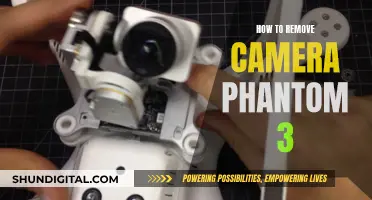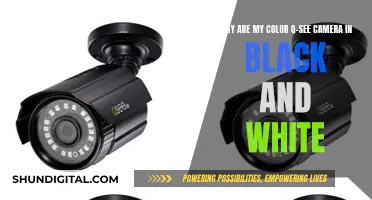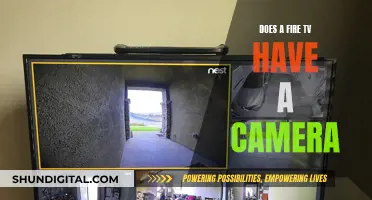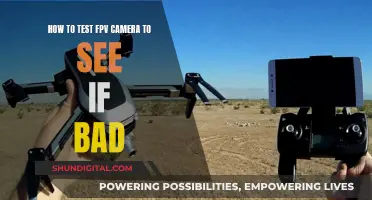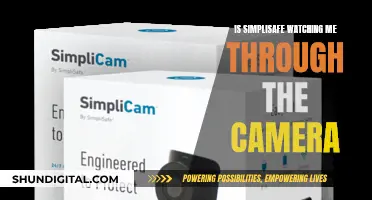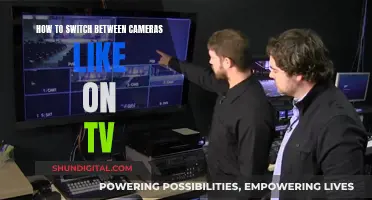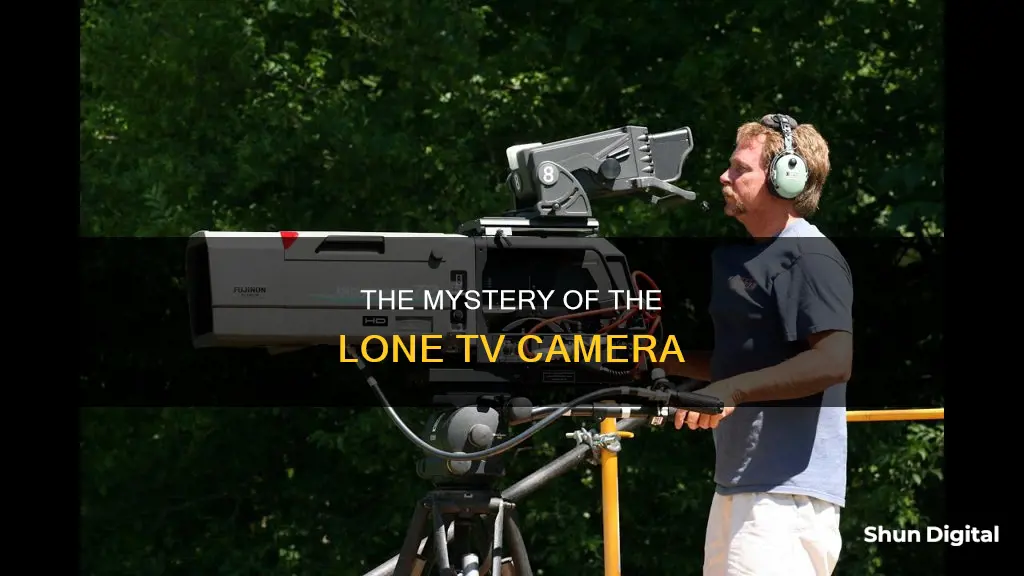
In television production, there are two main types of camera setups: single-camera and multiple-camera. The single-camera setup, as the name suggests, involves capturing all the shots and angles using the same camera. On the other hand, multiple-camera setups use several cameras to capture different angles of a scene simultaneously. Single-camera shows tend to look more like movies, with more freedom in shooting styles and locations, but they are more time-consuming and expensive. Multiple-camera shows are often associated with sitcoms and are usually shot in front of a live studio audience, allowing for faster production and lower costs.
| Characteristics | Values |
|---|---|
| Number of cameras | Single-camera shows are usually shot with one camera, but sometimes use more. Multi-camera shows use multiple cameras. |
| Set design | Single-camera shows are shot on location or on a set with four walls. Multi-camera shows are shot on a set with three walls and an audience making up the fourth wall. |
| Audience | Single-camera shows are not shot in front of a live audience. Multi-camera shows are. |
| Script format | Single-camera scripts are formatted like film scripts. Multi-camera scripts are formatted like plays, with action and scene description in CAPS, character names underlined, and dialogue double-spaced. |
| Cost | Single-camera shows are more expensive to produce. Multi-camera shows are cheaper. |
| Time | Single-camera shows take longer to shoot. Multi-camera shows can be shot in a few hours. |
| Editing | Single-camera shows allow for more control over each shot. Multi-camera shows allow for multiple takes at once and more choices in the edit. |
What You'll Learn

Single-camera shows are more like films
Single-camera shows are often more like films in their production and writing style. Although multiple cameras may be used, the show is edited from the perspective of a single camera to create a cinematic look. Single-camera shows are usually filmed on location, with dedicated crews and location scouts, and sets are built for places that may be returned to. This gives the director more control over each shot and allows for experimentation with shots and angles.
Single-camera shows are often more expensive and time-consuming to produce, as each scene is filmed from multiple angles and edited together in post-production. This gives the director greater freedom over camera movement and allows for more complex shots, such as over-the-shoulder shots of two characters in conversation.
Single-camera shows are also more similar to films in their formatting. Single-camera scripts are written in a similar format to movie scripts, typically 22-35 pages for a half-hour show. In contrast, multi-camera scripts have a more technical format, with action and scene descriptions in all caps, underlined scene headings, and double-spaced dialogue.
Single-camera shows often do not have a live studio audience, which gives them a different feel to multi-camera sitcoms, which are more like theatre. Single-camera comedies, in particular, tend to have a different style of humour, playing more like a feature comedy film.
Philips 65-inch 4K TV: Where's the Camera?
You may want to see also

Multi-camera shows are like theatre
Multi-camera shows are often filmed in front of a live studio audience, much like a theatre performance. The "play" is captured on multiple cameras as actors move between sets, usually in a single take. This is similar to a theatre performance, where the audience watches the actors move between sets in real time.
Multi-camera sitcoms are also similar to theatre in the way they are formatted. Multi-camera scripts have a more technical approach, with all action and scene description in capitals, character entrances and exits underlined, and more stage directions. This is similar to a theatre script, where stage directions are included to guide the actors' movements and the technical execution of the show.
Multi-camera sitcoms are also faster to produce than single-camera shows, as they are usually filmed in front of a live audience. This is comparable to theatre, where the performance is typically presented as a continuous piece, without stopping and starting between scenes.
Additionally, the humour in multi-camera sitcoms is often different from that in single-camera shows due to the presence of a live audience. This is similar to theatre, where the actors feed off the energy of the audience, and the humour may be adapted to suit the audience's reaction.
Overall, while there are some technical differences, the multi-camera setup in television shares some key similarities with theatre, particularly in the way the performance is captured and presented to the audience.
Stop TV Banding: Adjust Camera Settings for Better Quality
You may want to see also

Single-camera shows are more expensive
Single-camera shows give the director more control over each shot, but they are less versatile than multi-camera shows. Multi-camera shows are able to capture all the different camera angles of a scene simultaneously, and so are generally faster and cheaper to produce.
Single-camera shows are often more similar to films in terms of their humour and style, and they do not have a live audience. This means that single-camera scripts are usually 22-32 pages long, whereas multi-camera scripts are 52-58 pages long.
Viewing Zmodo Cameras on PC: A Simple Guide
You may want to see also

Multi-camera shows are faster to shoot
Single-camera shows, on the other hand, require more time and effort as each shot and camera angle is taken using the same camera, or multiple cameras pointed in one direction. This setup requires more time for lighting adjustments and camera repositioning between shots.
The multi-camera setup is particularly useful for sitcoms as it allows for the recording of an ensemble of actors presenting a single performance before a live audience from multiple perspectives. This technique is cheaper and takes less production time, making it a popular choice for sitcoms.
Single-camera shows, however, offer more versatility and control to the director, allowing for specific camera angles and movements that can enhance the visual style and impact of the show. This style is often preferred for dramas or shows that require frequent use of visual effects, as it provides greater flexibility and control over the final output.
In summary, while multi-camera shows offer speed and efficiency in shooting, single-camera shows provide greater creative control and versatility, albeit at the cost of increased production time and budget.
Syncing Camera Photos to TV: Easy Slideshow Guide
You may want to see also

Single-camera shows have more control over shots
Single-camera shows, as the name suggests, use one camera to shoot from multiple angles. This means that the camera can be moved and reset to get a new angle, giving the director more control over the shot. This is in contrast to multi-camera shows, which use multiple cameras to capture all the angles of a scene simultaneously.
The single-camera setup gives filmmakers more flexibility in terms of camera movement and the ability to shoot in smaller locations. They can also control aspects such as lighting for each shot. This setup is more time-consuming and expensive but allows for more creative and dynamic shots.
Single-camera shows are often shot like films, with dedicated crews, location scouts, and sets built for frequently used locations. This gives the show a more cinematic look and feel, as opposed to the more static and "stagey" look of multi-camera shows, which are often shot in front of a live studio audience.
Single-camera shows are usually reserved for dramas and made-for-TV movies, while multi-camera shows are typically used for sitcoms, talk shows, and reality TV series. However, in recent years, there has been a resurgence in the use of single-camera setups in sitcoms, such as in "The Office", "Modern Family", and "Curb Your Enthusiasm".
The choice between single-camera and multi-camera setups depends on the specific requirements of the show, including budget, location, and desired visual style.
Understanding Camera Basics: AV and TV Modes Explained
You may want to see also
Frequently asked questions
Single-camera shows are shot more like films, without a live audience. This gives the director more control over each shot and allows for more complex camera movements and angles.
Popular single-camera shows include "The Office", "Modern Family", "Barry", "Transparent", "Casual", "Law & Order", "Fargo", and "Friday Night Lights".
Single-camera shows offer more flexibility in terms of shooting locations and set design, as they are not limited by the need to accommodate multiple cameras and a live audience. This allows for more varied and complex sets, such as those used in dramas and certain types of comedies.
Single-camera shows can be more time-consuming and expensive to produce, as each scene needs to be shot from multiple angles and lighting and other factors need to be controlled for each shot.
Single-camera shows are typically written in a standard format similar to feature film scripts, while multi-camera shows have a more technical format with specific conventions such as underlined scene headings, character names, and sound effects.


